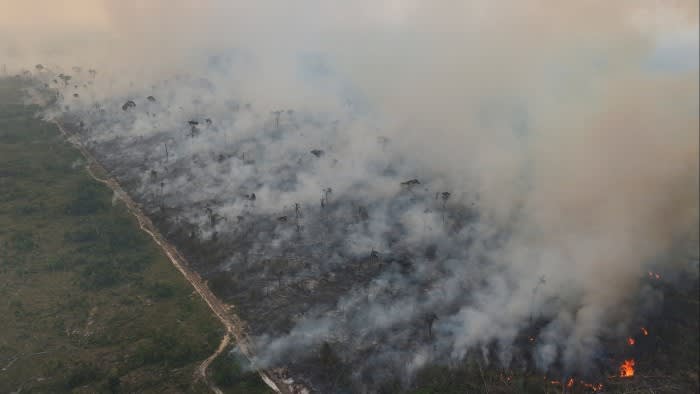Brazil is fighting wildfires that have cast smoke across swaths of its territory, fuelled by heatwaves and the nation’s worst drought on record.
The area of the Amazon in Brazil, home to about two-thirds of the world’s largest rainforest, suffered its highest number of blazes for 14 years in August, according to the national space research agency Inpe.
Other biomes scorched by flames include the vast tropical savannah called the Cerrado that stretches across the centre of the country and the Pantanal wetlands in its south.
The total area burnt this year in Brazil estimated at 34.5mn hectares — or about the size of Germany — more than double the average for the same period across 2012-2023, according to the Global Wildfire Information System (GWIS), a joint Copernicus and Nasa initiative that uses thermal anomalies detected by satellite to assess the burnt area.
While elevated temperatures of more than 40C in some places have combined with a prolonged dry spell to turn delicate ecosystems into tinderboxes, authorities have blamed human action for lighting the spark in many cases.
They single out “slash-and-burn” agriculture practised by some farmers and ranchers, as well as criminals looking to clear forested land.
Though fires on a small scale form part of the natural ecological cycle in the Cerrado and Pantanal, the intensity of this year’s burning season has caused serious alarm.
The government of president Luiz Inácio Lula da Silva, which has made environmental protection a priority, is sending extra resources to the most affected regions.
Despite a fall in Amazon deforestation under Lula, decades of destruction have contributed to the drought and infernos, according to geologist and climatologist Pedro Cortes, a professor at the University of São Paulo.
“A consequence of deforestation of the Amazon is that the replenishment of water and humidity in the atmosphere has been reduced,” he said.
This results in diminished rainfall from “flying rivers”, or clouds that form in the Amazon basin and transport water vapour to other parts of South America, Cortes explained.
Scientists say global warming is also playing a role in the meteorological phenomena afflicting Brazil.
“The evidence is clear: climate change is both contributing to and exacerbating these crises,” said Izabella Teixeira, a biologist and Brazil’s former environment minister.
“We also know that Brazil is much more likely to experience even more of these extreme weather events as climate change further intensifies.”
Smoke has shrouded skies across parts of South America as a result of fires spreading across countries including in Peru and Bolivia.
Bolivia declared a national emergency last week because of its largest number of forest fires since 2010, according to Inpe. In the capital La Paz, many schools closed as classes went online.
Brazil’s drought began in mid-2023 and has been described as the “most intense and widespread” in its history by the National Centre of Natural Disaster Monitoring and Alerts (Cemaden). The government agency says almost 60 per cent of Latin America’s largest nation is affected to some degree.
Last year, one factor was El Niño, the naturally-occurring weather pattern that warms the Pacific Ocean, said Ana Paula Cunha, a researcher at Cemaden. “This year there’s an even bigger contribution from the overheated north Atlantic,” she added.
Rain may offer relief in the central south of the country from next week, said Cunha, but below-average precipitation is forecast for the next three months in other states already facing a “critical” situation.
Major waterways in the Amazon basin have touched historic lows, complicating basic supplies for distant communities dependent on riverine transport. Elsewhere, crops ranging from coffee to oranges have been harmed.
The dry spell has also led regulators to increase energy bills, because the backbone of Brazil’s power generation is from hydroelectric dams and reservoir levels have dropped.
There is also an impact on human health. Wildfires have carried dangerous micro-particulate matter, blanketing both countryside and urban centres in muggy clouds.
On Thursday, the smoke plume reached about 33 per cent of national territory, with roughly 11 per cent of Brazil exposed to heavy smoke, according to Financial Times’ calculations based on data from the Copernicus Atmosphere Monitoring Service.
São Paulo, Brazil’s most-populous municipality, had the worst air quality of 120 major cities worldwide this week, according to the Swiss data platform IQAir. It found the country’s western Amazon region was the most-polluted area in the world last month because of wildfires.
“The scale of the emissions has grown to historic levels through August until now, around the typical peak season, with well above average emissions”, said Mark Parrington, senior scientist at Copernicus.
He said some regions, including Bolivia, Amazonas and Mato Grosso do Sul, were at or around their highest annual total fire emissions of the 22 years covered by the EU agency data set.
Fires across South America this year have emitted 72 per cent more carbon dioxide this year than the average for the same period in 2012-2023, according to the GWIS.
“This scenario will fuel climate change even more,” said Marcio Astrini, executive secretary at the non-profit Climate Observatory.
“We need more forceful action. This is the moment to increase punishments for environmental crimes in Brazil, especially those linked to fire and deforestation.”
Additional reporting by Beatriz Langella and Joe Daniels
Climate Capital
Where climate change meets business, markets and politics. Explore the FT’s coverage here.
Are you curious about the FT’s environmental sustainability commitments? Find out more about our science-based targets here
Source link : http://www.bing.com/news/apiclick.aspx?ref=FexRss&aid=&tid=66e5308d57e64e33aee343cf9ac0f2d7&url=https%3A%2F%2Fwww.ft.com%2Fcontent%2Fbdcdd185-73ba-411b-93f0-1a3b3b879834&c=9700387129699140319&mkt=en-us
Author :
Publish date : 2024-09-13 17:00:00
Copyright for syndicated content belongs to the linked Source.
